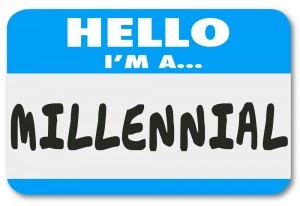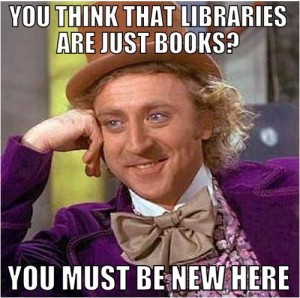
Millennials have long been the interest of researchers for their “advanced technology habits, their racial and ethnic diversity, their looser relationships to institutions such as political parties and organized religion, and the ways in which their social attitudes differ from their elders” (PEW, 2014). But for all their positive and interesting attributes, its seems that negative millennial stereotyping tends to dominate the discussion; millennials are a fickle, judgemental, cynical, materialistic, entitled bunch, lazy and just looking to have a good time. Perhaps the most overarching theme to come from these discussions is millennials’ dependance on technology and love of all things social media.
So why should public libraries care?
Millennials are often considered to be the most underrepresented user group in public library settings. While this is not entirely true, roughly 50% of young Americans aged 16-29 reported using their public library in the past year (PEW, 2014), younger Americans are among the least likely to say that libraries are important (PEW, 2014). Further, only 19% of this population stated that their library’s closing would have a major impact on them and their family (PEW, 2014). Obviously, in a world where budgets are already tight and the threat of closure or downsizing looms imminent, this statistic is significant.
So what can be done?

Tailoring library marketing campaigns to millennial patrons is one way of doing it. Seems simple, no? And with 90% of millennials are active on at least one social networking site (PEW, 2014), social media is the way to do it. Further, considering over three-quarters (77%) of younger Americans have a smartphone (PEW, 2014), public libraries have to find a way to appear on their phones!
But public libraries should be careful when using social media – we millennials can be a mean bunch.
For instance, while millennials want to be engaged with brands on social media, some take it too far and become annoying. Multiple posts across a variety of social media platforms becomes repetitive and boring to us. We like authentic and pithy content disbursed to us at regular, timely intervals. It should also be authentically pleasing enough to peak our interest. Got it? Good.
References
McClary, T. (2014, April 24). Marketing the Public Library to Millennials [Blog]. New Jersey State Library. Retrieved from http://www.njstatelib.org/blog/marketing/2014/marketing_the_public_library_to_millennials/
PEW Research Centre. (2014, September 10). Younger Americans and Public Libraries: How those under 30 engage with libraries and think about libraries’ role in their lives and communities. Retrieved from http://www.pewinternet.org/files/2014/09/PI_YoungerAmericansandLibraries_091014.pdf
The G Brief. (2016, January 14). Do Millennials Care About Traditional Libraries? [Blog] The G Brief. Retrieved from http://thegbrief.com/articles/do-millennials-care-about-traditional-libraries-609


